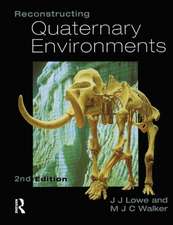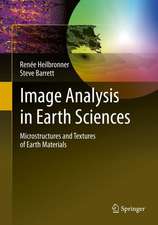Granite Genesis: In-Situ Melting and Crustal Evolution
Autor Guo-Neng Chen, Rodney Grapesen Limba Engleză Hardback – 26 iun 2007
In this book we suggest an alternative model for the origin of granite in terms of in-situ melting-intracrustal convection that physically determines the process from partial melting of mid-upper crustal rocks to formation of a convecting magma layer. We illustrate the model using geological, geochemical and geophysical studies from Australia, North and South America, Europe and China, and conclude that heat convection within a crustal partial melt layer is essential for the formation of granite magma and that without convection, partial melting of rocks produces migmatites rather than granites. Granite is layer-like within the crust, and shape and size of granite bodies reflect the geometric relationship between an irregular upper surface of the crystallised magma layer and depth of erosion. Repeated melting of the crust generates downward-younging granite sequences. Chemical and isotopic compositions of granites indicate differentiation within the magma rather than different deep sources.
Of a number of proposed heat sources that can cause mid-upper crustal anatexis, large-scale crustal melting and formation of a granite magma layer is considered to be primarily related to plate convergence. A dynamic model with examples from the western Pacific continental margin in SE China and Tethys-Tibet is proposed to explain the relationship between plate convergence, granite and compressive deformation of the continental crust. Mineralisation related to granite formation, fault-block basins, formation of continental red beds and volcanism with examples from SE China, are also discussed in terms of the new model. In a final section, we introduce a new rock cycling model of the continental crust and the concept of Geochemical Fields of Elements, illustrating the unity between the microcosm and macrocosm of the natural world.
Audience: This book will be of interest to scientists, researchers and students in geology, geophysics, geochemistry and economic geology
| Toate formatele și edițiile | Preț | Express |
|---|---|---|
| Paperback (1) | 944.36 lei 6-8 săpt. | |
| SPRINGER NETHERLANDS – 19 oct 2010 | 944.36 lei 6-8 săpt. | |
| Hardback (1) | 951.77 lei 6-8 săpt. | |
| SPRINGER NETHERLANDS – 26 iun 2007 | 951.77 lei 6-8 săpt. |
Preț: 951.77 lei
Preț vechi: 1160.70 lei
-18% Nou
Puncte Express: 1428
Preț estimativ în valută:
182.12€ • 190.63$ • 151.58£
182.12€ • 190.63$ • 151.58£
Carte tipărită la comandă
Livrare economică 01-15 aprilie
Preluare comenzi: 021 569.72.76
Specificații
ISBN-13: 9781402058905
ISBN-10: 140205890X
Pagini: 292
Ilustrații: XI, 278 p. 218 illus., 1 illus. in color.
Dimensiuni: 160 x 240 x 21 mm
Greutate: 0.63 kg
Ediția:2007
Editura: SPRINGER NETHERLANDS
Colecția Springer
Locul publicării:Dordrecht, Netherlands
ISBN-10: 140205890X
Pagini: 292
Ilustrații: XI, 278 p. 218 illus., 1 illus. in color.
Dimensiuni: 160 x 240 x 21 mm
Greutate: 0.63 kg
Ediția:2007
Editura: SPRINGER NETHERLANDS
Colecția Springer
Locul publicării:Dordrecht, Netherlands
Public țintă
ResearchCuprins
Preface.- Acknowledgements.- 1 Introduction.- 1.1 Rock genesis and its relationship to geosystems.- 1.2 Granites, migmatites and granite problems.- 2 Crustal melting: experiments and conditions.- 2.1 Introduction.- 2.2 Mineral melting.- 2.3 Rock melting – experimental evidence.- 2.4 Structure and composition of the crust.- 2.5 Water in the crust.- 2.6 Crustal heat and partial melting.- 3. In-situ melting and intracrustal convection: granite magma layers.- 3.1 Introduction.- 3.2 Crustal melting I: Initial melting and partial melt layer.- 3.3 Crustal melting II: Convection and formation of magma layer.- 3.4 Compositional variation within magma layer.- 3.5 Magma layer, granite layer and granite bodies.- 3.6 MI fluctuation (remelting) and granite sequence.- 3.7 Conclusion.- 4. Geological evidence for in-situ melting origin of granite layers.- 4.1 Migmatite to granite.- 4.2 Contact metamorphism.- 4.3 Xenoliths and mafic enclaves.- 4.4 Granite layer and granite exposures.- 4.5 Fluctuation of MI and downward younging granite sequence.- 5. Differentiation of magma layer: geochemical considerations.- 5.1 Introduction.- 5.2 Compositional variation.- 5.3 Strontium isotopes.- 5.4 Oxygen isotopes.- 5.5 Rare earth elements.- 5.6 Summary.- 6. Mineralisation related to in-situ granite formation.- 6.1 Introduction.- 6.2 Source of ore-forming elements.- 6.3 Formation and evolution of ore-bearing fluid.- 6.4 Types of mineral deposits.- 6.5 Age relationships.- 6.6 Temperature distribution.- 6.7 Formation and distribution of hydrothermal mineral deposits.- 6.8 Mineralised depth horizons.- 6.9 Mineralisation during elevated crustal temperatures.- 6.10 Mineralisation during granite remelting.- 6.11 Patterns of element redistribution and element fields.- 6.12 Summary.- 7. Heat source for crustal magma layers: tectonic models.- 7.1 Introduction.- 7.2 Crustal temperature disturbance related to plate convergence.- 7.3 Subduction and granite formation: western Pacific continental margin.-7.4 Continental collision and granite formation: Tethys Belt.- 7.5 Concluding statement.- 8. Geological effects of crystallisation of a crustal granite magma layer: SE China.- 8.1 Fault-block basins.- 8.2. Volcanism.- 9. Material and element cycling of the continental crust and summary.- 9.1. Rock cycling of continental material.- 9.2. Element cycling of the continental crust.- 9.3. Overview.- References.- Appendix 1 map of SE China.- Appendix 2 Results of experimental rock melting.- Index
Recenzii
From the reviews:
"Granite Genesis: In-Situ Melting and Crustal Evolution is a timely, well-structured, and enjoyable read. The authors provide a useful introduction to granite terminology and the ‘granite debate’ … The book benefits in continuity and style from having only two authors and is easy to read. … this book provides a valuable synthesis and is a great reference for all graduate students and professionals interested in granitic rocks, from their petrogenesis to emplacement mechanisms." (Victoria Pease, Geological Magazine, Vol. 146 (3), 2009)
"Granite Genesis: In-Situ Melting and Crustal Evolution is a timely, well-structured, and enjoyable read. The authors provide a useful introduction to granite terminology and the ‘granite debate’ … The book benefits in continuity and style from having only two authors and is easy to read. … this book provides a valuable synthesis and is a great reference for all graduate students and professionals interested in granitic rocks, from their petrogenesis to emplacement mechanisms." (Victoria Pease, Geological Magazine, Vol. 146 (3), 2009)
Textul de pe ultima copertă
Granitic rocks are a major component of the continental crust and the many and complex problems of their origin that have challenged geologists over some 200 years still are presenting challenges today. Current ideas of granite formation involve lower crustal melting, segregation, ascent (as dykes or diapirs) and emplacement in the upper crust.
In this book we suggest an alternative model for the origin of granite in terms of in-situ meltingintracrustal convection that physically determines the process from partial melting of mid-upper crustal rocks to formation of a convecting magma layer. We illustrate the model using the geological, geochemical and geophysical studies from Australia, North and South America, Europe and China, and conclude that heat convection within a crustal partial melting layer is essential for formation of granite magma and that without convection, partial melting of rocks produces migmatites rather than granites. Granite is layer-like within the crust, and shape and size of granite bodies reflect the geometric relationship between an irregular upper surface of the crystallised magma layer and erosion surface. Repeated melting of the crust generates downward-younging granite sequences. Chemical and isotopic compositions of granites indicate differentiation within the magma rather than different deep sources.
Of a number of proposed heat sources that can cause mid-upper crustal anatexis, large-scale crustal melting and formation of a granite magma layer is considered to be primarily related to plate convergence. A dynamic model with examples from the western Pacific continental margin in SE China and Tethys-Tibet is proposed to explain the relationship between plate convergence, granite and compressive deformation of the continental crust. Mineralisation related to granite formation, fault-block basins, formation of continental red beds and volcanism with examples from SE China, are also discussed in terms of the new model. Ina final section, we suggest a new rock cycling model of the continental crust and the concept of Geochemical Fields of Elements, illustrating the unity between the microcosm and macrocosm of the natural world.
Audience: This book will be of interest to scientists, researchers and students in geology, geophysics, geochemistry and economic geology.
In this book we suggest an alternative model for the origin of granite in terms of in-situ meltingintracrustal convection that physically determines the process from partial melting of mid-upper crustal rocks to formation of a convecting magma layer. We illustrate the model using the geological, geochemical and geophysical studies from Australia, North and South America, Europe and China, and conclude that heat convection within a crustal partial melting layer is essential for formation of granite magma and that without convection, partial melting of rocks produces migmatites rather than granites. Granite is layer-like within the crust, and shape and size of granite bodies reflect the geometric relationship between an irregular upper surface of the crystallised magma layer and erosion surface. Repeated melting of the crust generates downward-younging granite sequences. Chemical and isotopic compositions of granites indicate differentiation within the magma rather than different deep sources.
Of a number of proposed heat sources that can cause mid-upper crustal anatexis, large-scale crustal melting and formation of a granite magma layer is considered to be primarily related to plate convergence. A dynamic model with examples from the western Pacific continental margin in SE China and Tethys-Tibet is proposed to explain the relationship between plate convergence, granite and compressive deformation of the continental crust. Mineralisation related to granite formation, fault-block basins, formation of continental red beds and volcanism with examples from SE China, are also discussed in terms of the new model. Ina final section, we suggest a new rock cycling model of the continental crust and the concept of Geochemical Fields of Elements, illustrating the unity between the microcosm and macrocosm of the natural world.
Audience: This book will be of interest to scientists, researchers and students in geology, geophysics, geochemistry and economic geology.
Caracteristici
Provides a synthesis of current ideas of granite genesis in the earth's crust developed over the last 20 years Provides an alternative model for granite genesis and a reinterpretation of current ideas Highlights results of Chinese research (published in Chinese) over the last 30 years in English for the first time










